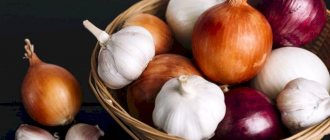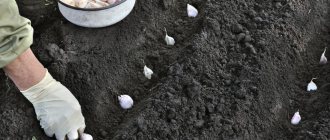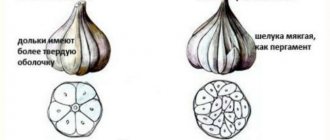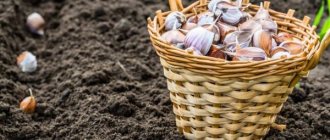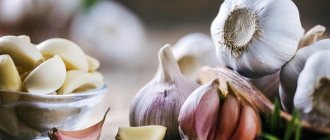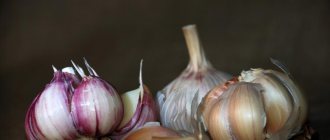Garlic is grown everywhere in Russia, including in the Urals. Although this area is one of the regions of risky agriculture, nevertheless, the Urals always plant garlic in the fall before winter.
Dear readers! For you, we have created communities on social networks in which useful articles and interesting ideas are published several times a day! Subscribe and receive useful content in a convenient format!
In today’s article we will talk about the timing and nuances of planting garlic in the fall in the Urals.
What to look for when planting garlic in the Urals
The Urals are famous for their cold winters, which can be dangerous even for such a frost-resistant plant as garlic.
Therefore, it is very important to follow the rules for planting in the fall.
Planting material must be appropriate. This means that it is necessary to select zoned varieties for the Urals and Siberia. Nazus, Gribovsky, Vyatsky, Novosibirsky, Amethyst, Yubileiny, Spas, Elenovsky, Gulliver, Lyubasha, Skif, Bashkirsky 85, Sofievsky, Lazurny, Dobrynya, etc. are suitable.
Also monitor the quality of planting material. Select whole, medium-sized cloves without external damage or visible disease.
IMPORTANT! Under no circumstances should you plant spring varieties in the Urals before winter! This is a grave mistake!
It is equally important to choose the right time for the procedure. We need to monitor the weather forecast. There is no change from year to year, and autumn can be different every time.
Another factor that directly affects the quantity and quality of the crop is the soil. Garlic loves neutral and slightly acidic soils.
The soil should be loose and fertile. The ideal option is sandy loam soils.
We also pay attention to predecessors. It would seem like a small thing. But in general this is a very important factor.
Zoned varieties
If in the middle zone the variety range is rich, then for the Urals it is limited. Not every representative is able to withstand severe winter frosts, a late onset of spring, or a lack of sunlight due to the predominance of cloudy weather. In addition, the short summer does not allow some representatives of the vegetable crop to ripen. To harvest, zoned varieties and hybrids are selected for planting.
"Scythian"
Development of the West Siberian vegetable experimental station, which is tolerant to white rot. The varietal representative demonstrates high productivity even in unstable weather. The weight of a marketable head with even cloves is 30-50 g. There are only 4-5 of the latter in the bulb. They fit tightly to each other. “Skif” has a spicy taste and a characteristic garlic aroma. Universal use - suitable for salting, marinating, salads, and preparing main courses.
"Bashkirsky 85"
Domestic variety with early ripening. Biological ripeness occurs 90 days after germination. Universal application. The dense heads weigh 65 g. The bulb consists of 3-4 cloves with a pungent taste and a purple-yellow husk. Subject to the rules of planting and cultivation, productivity in an area of 1 m² is 0.7 kg.
Attention! With tolerance to temperature fluctuations, there is a disadvantage - a tendency to bolt.
"Gradekovsky"
A proven variety that has been proven over the years and has been approved for cultivation in open ground since 1984. The leaf rosette consists of six dark green plates. Maximum quantity – 9 pieces. The aerial bulbs are purple. Although there are more cloves in the head than in previous representatives (up to 7 pieces), the mass of the bulb is less - up to 20 g. The ripening period is early. The pulp is dense with a pungent taste.
"Sofievsky"
The representative of the vegetable crop is valued for its cold resistance, productivity, excellent taste and commercial qualities. Since the variety belongs to the early group in terms of ripening, it is prone to bolting. The latter is compensated by large heads, which, subject to the cultivation characteristics, reach 120 g. The number of cloves in the onion is up to 10 pieces. The taste is semi-sharp, keeping quality is excellent. Tolerance to viral diseases is high.
"Dobrynya"
A winter variety with high productivity that takes a long time to ripen. From the emergence of seedlings to the harvest, 4 months pass, during which it is necessary to provide the plantings with proper care. Important characteristics: winter hardiness, tolerance to many specialized diseases. The mass of a commercial onion is 60 g. It consists of one of 6-10 cloves. Suitable for long-term storage. If the room is well ventilated, the period is six months. With dense planting, productivity reaches 2 kg/m².
"Lyubasha"
The result of the work of Ukrainian breeders. But it is perfect for growing in the Urals. Garlic is tolerant to fungal diseases and tolerates both low temperatures and dry weather. It is classified as a universal variety. The vegetable crop is unpretentious in care, undemanding to soil composition, and demonstrates stable productivity. The mid-season variety ripens 100 days after germination. The head of garlic is round-flat and consists of 4-7 cloves of 10-20 g each. The total weight of the bulb can reach 120 g.
"Dubkovsky"
Plants with medium height stems. The heads are small but dense. The weight of a commercial copy is 50 g. If the soils are fertile, then the weight may be greater. The head has a thickened shape. The color is creamy purple on the outside. There can be no more than three external scales. The inner, covering cloves are colored light brown. Tolerance to diseases is low. Universal application. But more often it is used fresh.
Attention! Important advantages of varietal garlic are frost resistance and the possibility of long-term storage.
How to choose the right date for planting winter garlic in the Urals
When choosing a date for planting garlic in the Urals, the following factors must be taken into account:
- weather;
- moon calendar.
Of course, check the weather first. If you do not have the opportunity to plant cloves on a successful lunar day, then it is better to do it under suitable conditions.
In general, summer residents from the Urals need to focus on the second half of September and, in a good year, the first ten days of October.
In what weather can and cannot be planted garlic?
The optimal weather for planting in the fall is clear, after rain, with an average daily temperature of no lower than 10 and no higher than 12 degrees Celsius.
If it is colder outside, it is better to postpone planting.
Do not carry out the procedure in heavy rain. Better wait until it's over.
But if the soil is slightly damp when planting, then this is even good.
Favorable days for planting garlic in the Urals in 2022 in the fall
Focusing on biodynamic farming, days when the moon is waxing are chosen for sowing garlic cloves.
In September 2022, this is the 1st day and the period from the 18th to the 30th.
In October 2022 this is the 1st day and the period is from the 17th to the 31st.
Unfavorable days for planting garlic in 2022
But during the full moon phase and on the new moon, the vegetable is planted.
In 2022, landing is prohibited on September 2, 17 and October 2, 16, 31.
What signs and beliefs are there?
There are several signs among people that determine that it is time to plant garlic cloves.
According to them, garlic is planted when:
- hands become chilly without gloves;
- birds fly south;
- walking barefoot on the ground is cold;
- the first snow will fall;
- under the Intercession day.
Climate Features
The weather conditions of the Ural region are determined by its geographical location, location in the interior of the continent and distance from the ocean. The northern part of the region reaches the polar seas. Agriculture is impossible there. The southern part of the Urals adjoins the Kazakh steppes. The climate in this region is mountainous, and on the plains it is continental. Conditions in this region are harsh. The mountains stretching from north to south act as a climate barrier.
In the western part of the region, the climate is moderately humid due to high rainfall. In the eastern part there are half as many of them, so it is much drier there. The weather conditions in this region are greatly influenced by air masses carrying moisture from the Atlantic Ocean. The eastern part is often dry and cold due to arctic influences. Warm air from Central Asia comes from the south. Therefore, the weather here is often changeable.
It is warmest in the southern part of the Ural region. In the north there is the least solar radiation. In the polar part, winter is cold, lasting at least 8 months a year. Summer is very short, its duration does not exceed 45 days. In the south of the Urals, the duration of winter is not long, and warm weather lasts from 4 to 5 months. Autumn and spring have different durations in different parts of the region. Closer to the south there is a short autumn and a long spring, in the northern part the picture is the opposite.
Planting garlic before winter in the Urals, step-by-step diagrams
As in the rest of Russia, garlic is traditionally planted in the Urals using the ribbon and square-cluster methods.
The first scheme is suitable when planting vegetables in a narrow and long area. The second is when planting in a small patch of garden.
However, the schemes are not fundamentally different from each other. Be sure to maintain the distance between the cloves and bury them at the required depth.
Let's talk about each scheme in a little more detail.
Tape scheme
Step 1. Prepare the area for the garden bed. We dig, loosen, remove weeds.
Step 2. A month before planting, add 10 kg of humus per square meter.
Step 3. Mark the beds. Leave 20–30 cm between rows.
Step 4. Make grooves 10-12 cm deep.
Step 5. If there has been no rain, then moisten the soil at the bottom of the furrow.
Step 6. Plant the cloves bottom down, pressing them only a little into the ground.
Step 7. Cover with soil. Lightly compact.
Step 8. Mulch the bed or cover it with agrofibre. We put a shelter on top for the winter.
Square nest method
The step-by-step scheme is absolutely the same, only not grooves are made, but separate holes 15-20 cm from each other.
This method is used only if there is not a lot of planting material. Otherwise, it is inconvenient to make many holes.
At what depth to plant garlic?
The Urals have fairly cold winters, so it is very important to plant garlic at such a depth that it does not freeze.
The optimal depth is considered to be at least 10 cm (preferably 12).
Additionally, to protect against frost, the beds are mulched with sawdust and covered with dry grass and spruce branches.
What distance should be
It is necessary to maintain a step of 10 cm between adjacent cloves. However, if the garlic is large, then the distance can be increased.
There is no need to plant too often, the vegetable will become small.
Approximately 20-30 cm are left between rows. This distance is due to the ease of caring for the crop.
You can make double rows. That is, between adjacent rows the step will be 15 cm, then 30 cm of empty space and two more beds with a gap of 15 cm. This is done to make it convenient to water, loosen and weed the crop.
After what crops is garlic planted?
When choosing a place for garlic beds, pay attention to those areas of your garden where peas, beans, pumpkins, and cucumbers used to grow.
Areas for clover, buckwheat, mustard and other green manure crops are also suitable. Green manure gives the earth a rest and saturates it with useful microelements.
It is also useful to plant green manure for the same purpose after garlic.
After which you can’t plant garlic
Potatoes, beets, rapeseed, and bulbs (including garlic) are bad predecessors for garlic.
Also not the best choice is planting after herbs and greens.
The fact is that these crops absorb the same microelements as garlic. And after them there simply won’t be enough nutrition for him to fully develop.
In general, do not grow a crop in one place for 2 years in a row. Plant once every four years. This way the soil will be completely restored, and you will get a harvest of large heads.
Suitable neighbors for garlic
You can place garlic beds next to carrot, cucumber and tomato beds.
Nowadays, planting garlic and strawberries in the same bed is quite popular. Some gardeners believe that plants have a beneficial effect on each other.
How to properly prepare a garden bed
The area for planting must be prepared in advance. In good soil, the crop grows much faster and forms larger heads.
Site preparation in the fall is carried out approximately a month before the intended planting. This period is determined by the time required for organic fertilizers to rot in the soil and saturate it with useful elements.
First, decide on a location for your garlic beds. It is best to choose areas that are slightly above the surface. Also make sure that the place is well lit by the sun and ventilated.
Plant in the right soil. The crop grows very poorly on loam. The ideal soil is sandstone, but black soil is also suitable.
Secondly, dig up the soil and remove all weeds, plant remains, roots, etc. The soil must be loose and clean.
Third, apply fertilizer. It is best to use a mixture of organic and mineral water. For example, 10 kg of compost + a matchbox of superphosphate + a matchbox of potassium salt.
IMPORTANT! There is no need to put anything directly into the furrow or planting hole when planting!
What fertilizers can be applied when planting in the Urals
In general, no fertilizers are applied during direct planting.
Usually the soil is fertilized about 30-50 days before the procedure.
But, if you did not have time to do this due to the weather or lack of time, then you can add mineral preparations to the garden bed.
These are superphosphate and potassium salt. The consumption rate is one matchbox per square meter.
In any case, do not allow the cloves to come into contact with the granules. There should be at least a small layer of earth between them.
ON A NOTE. If you do not want to use mineral complexes, then remember that organic matter is added no later than 30 days before planting in the fall.
Unfavorable dates
The ebb and flow of tides and other natural phenomena are directly dependent on the movement of the night celestial body across the sky. For the cultivation of crops in which the root part is valuable, the time of the waning moon is chosen. During this period, there is an outflow of juice from the vegetative mass. Although landing among the growing satellite is permissible. Unfavorable dates occur during the new and full moon phases.
During such periods, plants are depressed and germination rates drop noticeably. When planting during these phases, there is a high risk of crop failure. In the worst case, the heads will not only be underdeveloped, but may not form at all. It is difficult to avoid the negative impact of the Moon - it is better to refrain from carrying out field work during prohibited times.
See the calendar above for unfavorable days.
Attention! To obtain large heads, first determine the appropriate time based on the temperature regime, and then select the best numbers from the table of the influence of the phases of the Moon.
Caring for garlic in the fall, preparing for winter in the Urals
Garlic planted in the Urals in the fall does not require any special care.
If you did everything correctly, the cloves will take root before the onset of cold weather, overwinter and begin to grow with the first warm days.
The harsh winters of the Urals require a special approach to covering beds.
Firstly, this procedure should never be neglected.
Secondly, first mulch the bed with sawdust, and only then cover it well with spruce branches, branches, dry grass, etc.
You can put agrofibre between the mulch and the shelter if a particularly harsh winter is expected.
It will be bad if there is little snow. After all, snow is a natural shelter. If possible, add more of it to the garden bed.
Planting dates according to the lunar calendar
Many gardeners prefer to learn about when to plant winter garlic from the lunar calendar. It is quite possible that the phases of the Earth's satellite actually somehow influence plant growth. Since this year everyone has already planted garlic a long time ago, we will give a deadline for next year. In 2015, according to the lunar calendar, winter garlic will need to be planted either on October 4-5, or from 12 to 15.
Planting garlic before winter according to the lunar calendar for the Southern Urals will most likely be optimal in the second term, for the Middle Urals - in the first.
Common mistakes
- Selecting the wrong variety. Plant varieties zoned for the climate of the Urals tolerate winter more easily and produce better harvests.
- Early or late planting in autumn before winter. Both will lead to the death of planting material. Sowing is carried out a month before the onset of cold weather.
- Planting in dry soil. Of course, there is no need to plant cloves in a swamp. The ideal option is damp soil after light rain. If autumn is dry, water the furrow before planting.
- The bed is not covered. Novice gardeners often forget about covering their garlic beds at the end of autumn.
- Landing in the lowlands. The garlic bulb is very susceptible to moisture. If you plant a plant in a lowland, then in the spring melt water will accumulate there. This will lead to rotting of the head and the development of fungal diseases.
- Too frequent arrangement of teeth. In an effort to save space in the garden, gardeners plant cloves too close to each other. This is not a critical error, but it does cause the heads to be small.
- Planting spring varieties. Beginning gardeners make this mistake. They think there is no difference, but it is huge. Spring garlic simply will not survive and will freeze.
Spring and winter crops
It is important to know the differences between spring and winter crops. The first type is planted in early spring, and the second in the fall, towards the onset of winter. Basically, gardeners prefer the winter type of garlic. But you can grow both. How to distinguish spring garlic from winter garlic at first glance? The teeth of the first type are smaller. Winter garlic cloves stand in a single row around the stem. In spring species you can find stemless varieties. In addition, the differences between spring and winter bulbous plants lie in their methods of propagation. The winter species reproduces using airy bulbs on arrows or cloves. Another species does not form bulbs, so it can only be propagated by teeth. Both types of garlic require approximately the same care; growing winter garlic is similar to growing spring garlic.
Latest articles about gardening
How to properly plant black currants in the fall?
How to plant tulips in the fall?
The technology for growing this crop is simple, but you should know several requirements and nuances, as well as provide the necessary care. Soil fertility is very important for this crop. It is recommended to plant winter bulbous plants on highly fertile loamy or sandy loam soils. It is important that the acidity of the soil is neutral or close to it.
Almost any variety of winter garlic shoots, which takes up a lot of nutrients, causing the bulbs to become small. Therefore, it is advisable to cut off the arrows. Before harvesting, it is recommended not to water the beds for 2-3 weeks so that the garlic dries out faster before storing. About three weeks before harvesting, it is advisable to loosen the beds.
Winter garlic is stored much worse than spring garlic - on average 5-7 months, it is not always possible to preserve it even until the end of winter, it dries out quite quickly and loses its useful and tasteful qualities. Storage in a cool place, such as a cellar or refrigerator, is recommended.
Answers to frequently asked questions
Is it possible to grow garlic in the Urals?
Certainly. Use zoned varieties and follow planting rules in the fall.
In what month should you plant garlic in the Urals?
Try to finish planting in early October to be sure to do it before the cold weather.
What temperature should it be outside?
The optimal value is +10 +12.
Can I plant in the fall after rain?
Even necessary. But make sure that the soil at the planting depth is not very moistened. And be sure to do some loosening.
Disease Prevention
Garlic is susceptible to diseases such as fusarium, white rot, and black mold. Fighting diseases is difficult. It is easier to follow preventive measures. It is necessary to soak the cloves in a solution of potassium permanganate or Fitosporin before planting. When the first signs of infection appear, it is better to immediately spray the garlic with a solution of Bordeaux mixture.
Onion fly and nematode can also cause damage. A good effect is achieved by deep digging of the site, timely destruction of plant debris and planting chicory and calendula on the site. These plants repel pests. To combat onion flies, special solutions are used. You can cook them yourself. An infusion of tobacco dust (1 glass per 2 liters of boiling water) helps a lot.
Top dressing
Before the growing season begins, the plant does not need additional nutrients. As soon as the first green leaves appear above the soil surface, fertilizing should be done.
It is divided into three stages:
- after the snow cover melts, water the garlic with a urea solution at the rate of 1 tbsp. l. per 10 liters of clean water. There is no need to be zealous - the consumption of the finished product should be 2 liters per 1 square meter. m;
- after 2 weeks, the garlic is “fed” with a weak solution of nitrophoska - 2 tbsp. l. per 10 liters of clean water. For 1 sq. m. beds with spices should contain no more than 2 liters of nutritional composition;
- in mid-June, be sure to generously water the area with garlic with a superphosphate solution. 2 tbsp. l. fertilizers are diluted in 10 liters of clean water per 1 sq. m area with a plant, you will have to pour 4 liters of the finished composition.
If ready-made mineral compositions do not suit lovers of natural fertilizers, you can use a weak solution of mullein - 1:7. First, pour several buckets of water into 10 kg of waste in a suitable container and let it sit in the sun for at least 10 days.
You can also use droppings, but you will have to prepare the solution in a different proportion - 1:15. Watering beds with garlic with natural compounds should be done with caution - these substances are quite aggressive towards the young greenery of the plant.
Rate the author of the material. The article has already been rated by 21 people.
